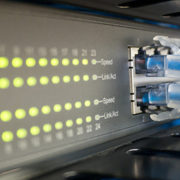Top 3 IT trends impacting data center infrastructure
As technology continues to play an increasingly large role in the enterprise, the investment in infrastructure to sustain the necessary hardware and software has become overwhelming for many organizations, especially those in the public sector. Managing in-house IT systems without the help of an expert third party can sometimes be incredibly expensive and complicated, and few agencies have the budget or manpower to address server sprawl or maintain outdated systems and infrastructure components on their own. Conversely, while many organizations are offloading assets to the public cloud, such a strategy involves giving up a lot of control and direct oversight over data, something that government agencies simply can't do.
In order to cope with growing technological demands, many public sector organizations are now looking to take advantage of emerging IT trends – hybrid cloud computing, mobility, big data – to offload their data center operations. State and local agencies are beginning to take advantage of the increased capabilities these new innovations offer by modernizing their data center technologies and applying hybrid cloud services wherever possible. These changes help to improve the efficiency and cost-effectiveness of their data center infrastructure, as well as protect against hardware and software failure.
Mobility
Public sector IT administrators find themselves caught between a rock and a hard place with new mobile technologies, as they offer employees a variety of benefits but also present widespread security and infrastructure challenges. Network strain, increased bandwidth demands, additional storage needs and more strict security measures all become necessary when an increased number of mobile devices are put to work within an organization. Most public sector IT departments do not have the human or fiscal resources necessary to improve and secure mobile access as they are already at their limits trying to support current data center operations. To solve this problem, many organizations are employing virtualized machines and storage to keep up with the bandwidth demands and user expectations.
Hybrid cloud computing
The ability of cloud solutions – when properly paired with on-premises options – to reduce server sprawl and maintenance worries are drawing many government agencies to the technology, and many have adopted cloud services for all of their routine business processes. A survey of government IT executives conducted last year by American City & County magazine revealed that almost half of all respondents utilized cloud services, with the most common use case being email and data storage. Participants reported experiencing a number of advantages after employing a cloud platform, including better accessibility from mobile devices, reduced IT infrastructure build-out and maintenance cost and improved management efficiency. While many government agencies aren't able to use public cloud providers because they do not hold the necessary state and local certifications, alternative solutions like colocation and shared private cloud environments are rapidly being employed.
Big data
With so many business functions revolving around the Internet these days, government agencies and public sector organizations are dealing with massive amounts of data on a daily basis. The advent of big data analytics is making these data stockpiles incredibly useful by allowing groups to improve efficiency and decision-making, as well as creating a better understanding of citizens' needs. However, most agencies have less than half of the necessary storage capacity and computing power to effectively leverage their big data initiatives, according to the American City & County survey.
A major hurdle when employing data analytics is sufficiently meeting federal, state and local regulations regarding the proper collection and storage of data. In order to effectively secure their information, IT departments should look to utilize a tiered storage model. Each tier is dictated by specific spending, access and capacity requirements, providing each type of data with the right amount of access and security, which is generally more cost effective. Different categories of data are assigned to different types of storage solutions, placing the most sensitive information that is frequently accessed in storage from which it can be retrieved easily and data that is less critical would be kept in lower storage.
Increasing focus on data center infrastructure
Taking advantage of the hybrid cloud, mobility and big data can completely transform public sector IT operations, but changes must be made to data center infrastructure. Agencies can improve the way they manage their computing facilities and boost data center efficiency by making enhancements in key areas like power usage, virtualization, data storage and network infrastructure. Changes in any of these categories would contribute to the improved efficiency, performance and cost savings of data center infrastructure, as well as creating more resilient facility.









